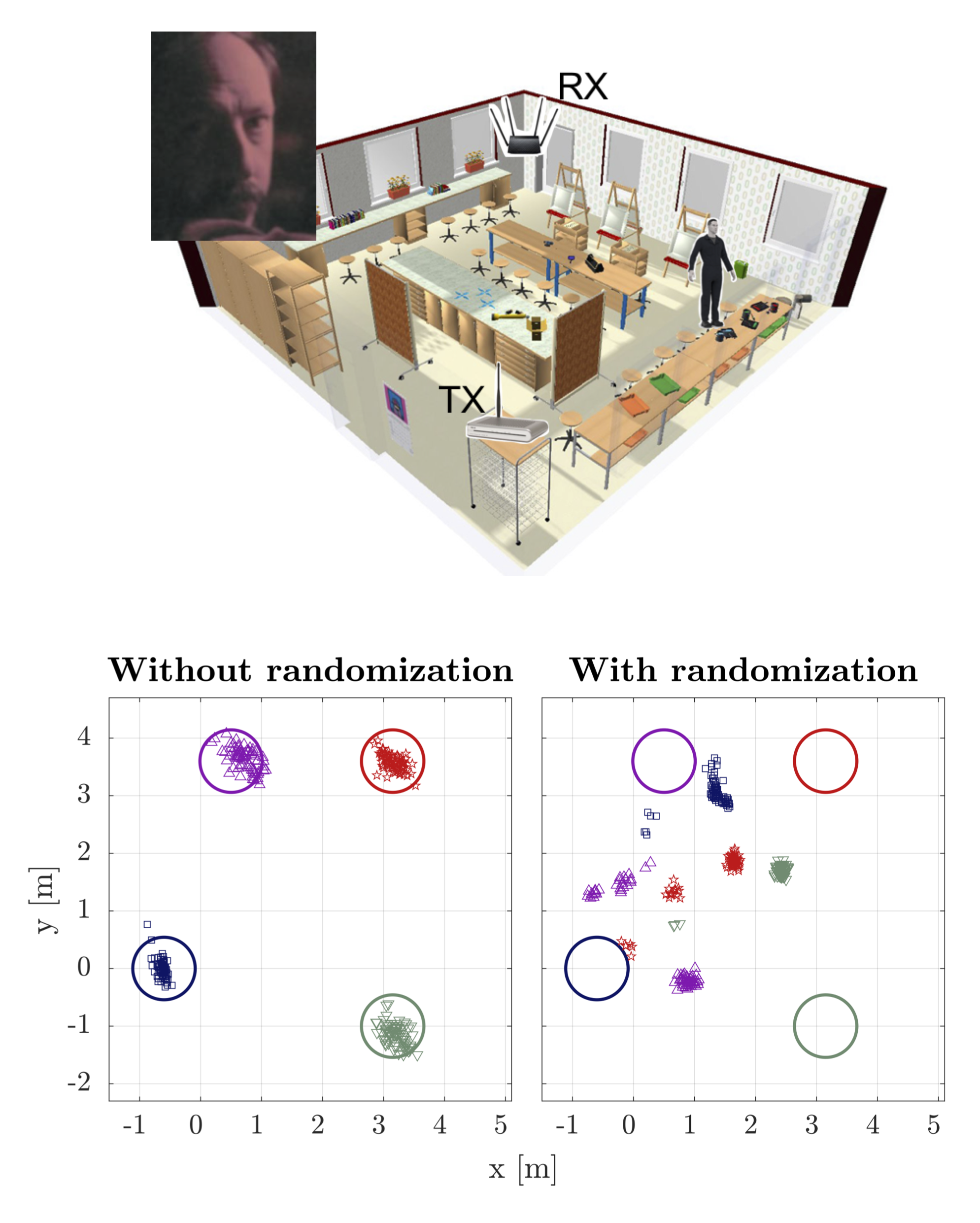Project description
 CSI-MURDER takes the move from one of the most flourishing research topics in wireless networks: the ability to exploit communication signals to sense the surrounding environment and hence to localize people and possibly objects.
Instead of proposing yet another localization system, this project explores the possibility of preventing unauthorized localization without hampering communication performance.
Sensing techniques use the Channel State Information (CSI) embedded in each Wi-Fi frame for understanding how wireless signals propagate in the environment: for instance, by measuring how CSI amplitude changes over time, it is possible to detect human presence or motion, recognize different types of activity, even detect specific gestures or measure human breathing, albeit these fine-grained detection has proven hard to replicate.
This project tackles the problem of neutralizing unauthorized surveillance while preserving communication performance. To this end, we implemented several functions for modifying Wi-Fi frames before they are transmitted over the channel so that receivers can still decode their content while eavesdroppers cannot use the CSI for sensing the environment.
CSI-MURDER takes the move from one of the most flourishing research topics in wireless networks: the ability to exploit communication signals to sense the surrounding environment and hence to localize people and possibly objects.
Instead of proposing yet another localization system, this project explores the possibility of preventing unauthorized localization without hampering communication performance.
Sensing techniques use the Channel State Information (CSI) embedded in each Wi-Fi frame for understanding how wireless signals propagate in the environment: for instance, by measuring how CSI amplitude changes over time, it is possible to detect human presence or motion, recognize different types of activity, even detect specific gestures or measure human breathing, albeit these fine-grained detection has proven hard to replicate.
This project tackles the problem of neutralizing unauthorized surveillance while preserving communication performance. To this end, we implemented several functions for modifying Wi-Fi frames before they are transmitted over the channel so that receivers can still decode their content while eavesdroppers cannot use the CSI for sensing the environment.

Example
Imagine that someone wants to illegally track the position of a person inside a laboratory, for instance to measure how much time is spent doing different activities at different desks, as depicted in the upper picture. How much effective can this attack be?
Actual experiments, reported in the lower picture on the left, show CSI-based localization can be extremely accurate, as all the estimated points fall within the circles representing different target positions. With CSI-MURDER, the localization becomes impossible because results will seem random, thus preserving the person privacy without destroying Wi-Fi communications.
Project continuation
CSI-MURDER continues beyond the financial support of the ORCA Project, which has been fundamental to bootstrap our activities, but it’s over.
Interested readers can find all the documents and the tools for evaluating the performance of the system on github and in the following sections.
Related material
Publications
-
Marco Cominelli, Francesco Gringoli, and Renato Lo Cigno. “AntiSense: Standard-Compliant CSI Obfuscation Against Unauthorized Wi-Fi Sensing”. Computer Communications, Elsevier. Available online 30 December 2021. In Press.
Publisher site; Local PDF preprint. -
Marco Cominelli, Francesco Gringoli, and Renato Lo Cigno. “Passive Device-Free Multi-Point CSI Localization and Its Obfuscation with Randomized Filtering”. In 19th Mediterranean Communication and Computer Networking Conference (MedComNet’21), June 15-17, Virtual Conference, pp. 1-8. The paper received the “Mario Gerla Best Paper Award”
Publisher site; Local PDF preprint. -
Marco Cominelli, Francesco Gringoli, and Renato Lo Cigno. “Non Intrusive Wi-Fi CSI Obfuscation Against Active Localization Attacks”. In 16th Wireless On-demand Network systems and Services Conference (WONS’21), March 9-11, Virtual Conference, pp. 1-8.
IFIP Digital Library; Xplore version; Local PDF preprint. -
Marco Cominelli, Felix Kosterhon, Francesco Gringoli, Renato Lo Cigno, and Arash Asadi. “An Experimental Study of CSI Management to Preserve Location Privacy”. In 14th International Workshop on Wireless Network Testbeds, Experimental evaluation & Characterization (WiNTECH’20), September 21, 2020, London, United Kingdom. ACM, New York, NY, USA, 8 pages.
Publisher site; Local PDF preprint. -
Marco Cominelli, Felix Kosterhon, Francesco Gringoli, Renato Lo Cigno, and Arash Asadi. “IEEE 802.11 CSI randomization to preserve location privacy: An empirical evaluation in different scenarios”. Elsevier Computer Networks, vol. 191, 22 May 2021, pp. 107970:1-2.
Publisher site; Local PDF preprint.
Additional Data
- Our CSI Dataset is available on Zenodo. This dataset has been used in our latest publication “AntiSense: Standard-Compliant CSI Obfuscation Against Unauthorized Wi-Fi Sensing”.
- The code we used to assess the performance of the Localization System is available on GitHub.
- Other CSI data we have collected in our lab are available here. (SHA-1: 4b19b47e811cc35cf390f5722f30750300db7788)
Other documents
About openwifi
During this project we developed, with the help from our Patron IMEC, a modified version of openwifi embedding the randomization mechanism. Interested readers can find more information about openwifi here.
Acknowledgements
We thank our Patron IMEC for their support in the development of the privacy-preserving feature inside the openwifi 802.11 stack.
CSI-MURDER has been funded by the European Commission under the Horizon 2020 Orchestration and Reconfiguration Control Architecture – ORCA project (grant no. 732174) Open Call 3 “Experimental analysis of CSI based anti-sensing techniques - CSI-MURDER” experiment.

